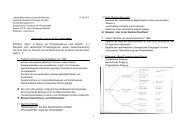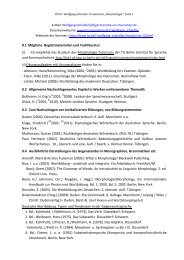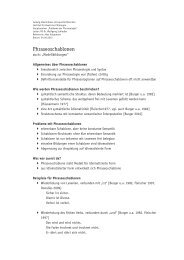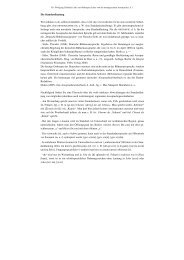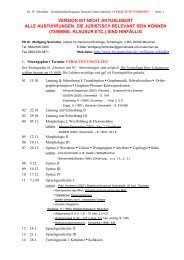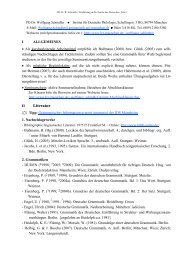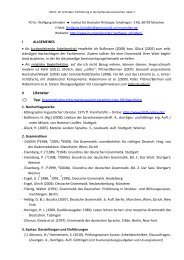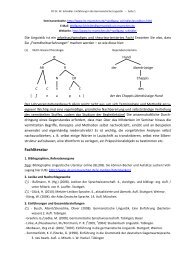Chapter 18 Lexical Functions: Description of Lexical Relations in a ...
Chapter 18 Lexical Functions: Description of Lexical Relations in a ...
Chapter 18 Lexical Functions: Description of Lexical Relations in a ...
You also want an ePaper? Increase the reach of your titles
YUMPU automatically turns print PDFs into web optimized ePapers that Google loves.
Def<strong>in</strong>ition <strong>18</strong>.2 [= 19.11]: Collocation <strong>of</strong> the lexical unit L<br />
—<strong>Chapter</strong> <strong>18</strong>. <strong>Lexical</strong> <strong>Functions</strong>— 10<br />
Let there be, <strong>in</strong> the lexicon <strong>of</strong> language L, two LUs—L and L´; L is taken as the start<strong>in</strong>g<br />
po<strong>in</strong>t, that is, as the keyword.<br />
A phrase L—L´ = 〈(S) ; /L/ ⊕ /L´/ ; Σ L⊕L´ 〉 which is a semantic phraseme <strong>of</strong> L is called a<br />
collocation (<strong>of</strong> L) iff it satisfies simultaneously the follow<strong>in</strong>g three conditions:<br />
1. The mean<strong>in</strong>g <strong>of</strong> the keyword L is the semantic pivot <strong>of</strong> the expression<br />
The signified (S) <strong>of</strong> the expression L—L´ <strong>in</strong>cludes the signified <strong>of</strong> L as its semantic<br />
pivot [see Def 19.11]: (S) = (C)((L)).<br />
2. The keyword L is selected <strong>in</strong>dependently<br />
In the process <strong>of</strong> text synthesis the LU L is selected by the Speaker <strong>in</strong>dependently <strong>of</strong><br />
L´—for its own signified (L).<br />
3. The keyword L controls the selection <strong>of</strong> the other constituent L´<br />
L´ is not selected unrestrictedly: it is selected for the signified (C) as a function <strong>of</strong> L.<br />
The LU L is the base <strong>of</strong> the collocation L—L´, and L´ is its collocate.<br />
NB: Note the two senses <strong>of</strong> the term base: the base <strong>of</strong> a semantic derivation vs. the base <strong>of</strong> a collocation.<br />
Although the two notions are not identical, they are <strong>in</strong>timately related, and this fact will be reflected <strong>in</strong><br />
us<strong>in</strong>g the same term for both when represent<strong>in</strong>g the semantic derivations and the collocations via <strong>Lexical</strong><br />
<strong>Functions</strong>: both will be called keywords.<br />
For all comments, explanations and examples with respect to collocations, the reader is<br />
referred to <strong>Chapter</strong> 19, pp. 00ff.<br />
1.4 Overlap <strong>of</strong> Semantic Derivations and Collocations<br />
An important property <strong>of</strong> semantic derivations and collocations is that the two sets have a very<br />
significant overlap: on the one hand, there are l<strong>in</strong>guistic expressions that look like semantic<br />
derivations but <strong>in</strong> fact manifest ‘fused’ collocations, while, on the other hand, some expressions<br />
that are collocations actually hide underneath ‘split’ derivations. Thus:<br />
• The verb BLASTV ([to] attack vigorously), as <strong>in</strong> The council blasted the university adm<strong>in</strong>istra-<br />
tion for this botched attempt, could be considered a semantic derivative <strong>of</strong> the verb ATTACKV<br />
(verbally)—the relation between BLASTV and ATTACKV corresponds to Def. <strong>18</strong>.1. However, the<br />
semantic difference (d) <strong>in</strong> this case is (<strong>in</strong>tensely), and this mean<strong>in</strong>g—<strong>in</strong>tensification—is currently<br />
expressed <strong>in</strong> English by separate LUs: [to] ATTACK vigorously, [to] APOLOGIZE pr<strong>of</strong>usely, ravenous<br />
APPETITE, close SHAVE, THIN as a rake, ANXIOUS as a cat on a hot t<strong>in</strong> ro<strong>of</strong>, etc. (all boldfaced LUs<br />
are <strong>in</strong> fact expressions <strong>of</strong> the <strong>Lexical</strong> Function Magn, see…). Therefore, it is preferable to consider<br />
BLASTV as a ‘fused’ collocation <strong>of</strong> the type ATTACKV VIGOROUSLY and treat it <strong>in</strong> the dictionary as a


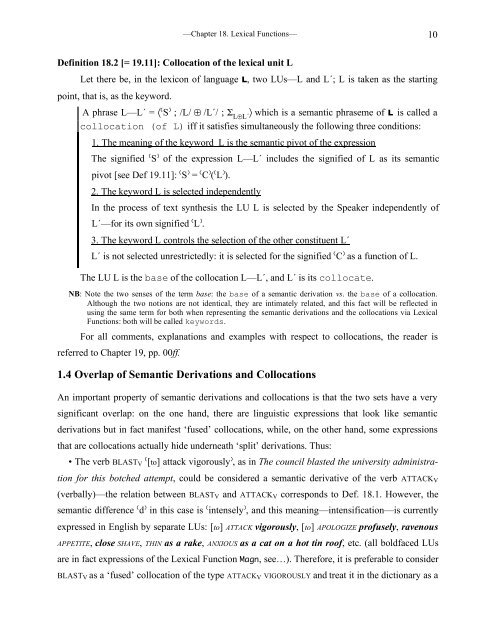
![E-Mail: Wolfgang.Schindler[ätt]germanistik.uni-muenchen.de Web ...](https://img.yumpu.com/51590147/1/184x260/e-mail-wolfgangschindlerattgermanistikuni-muenchende-web-.jpg?quality=85)
